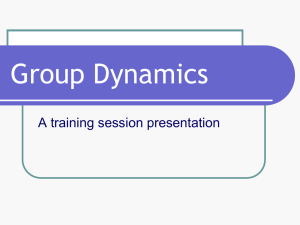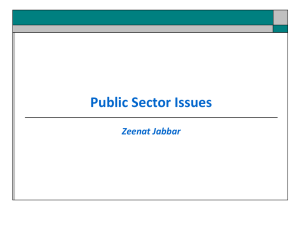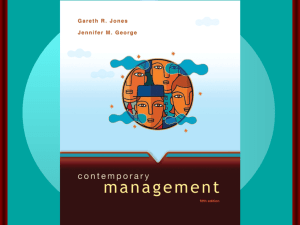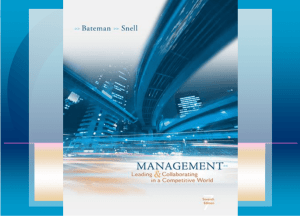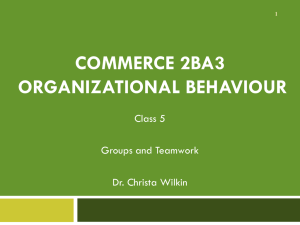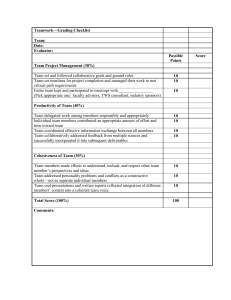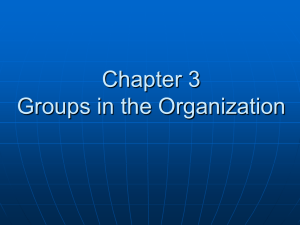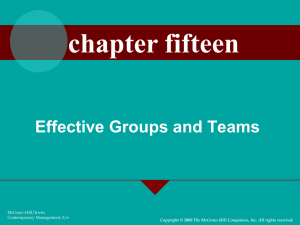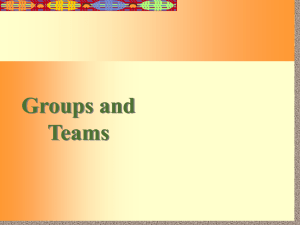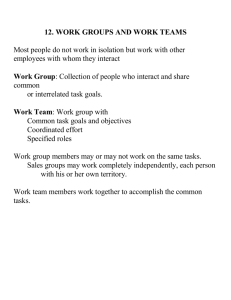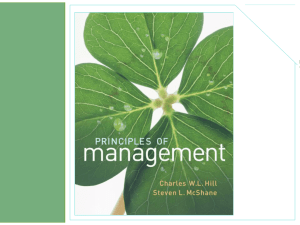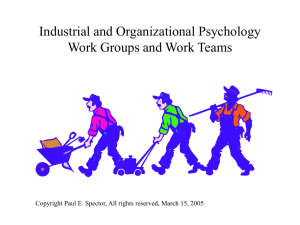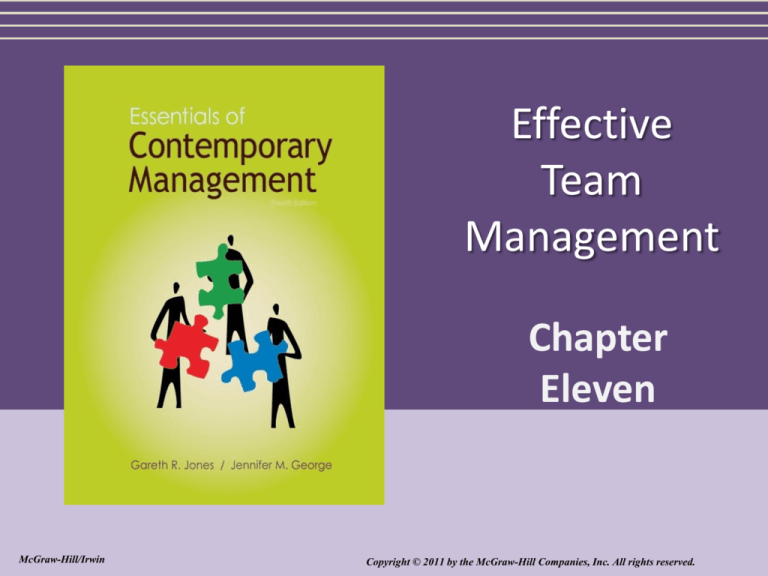
Effective
Team
Management
Chapter
Eleven
McGraw-Hill/Irwin
Copyright © 2011 by the McGraw-Hill Companies, Inc. All rights reserved.
Learning Objectives
LO1 Explain why groups and teams are key
contributors to organizational effectiveness.
LO2 Identify the different types of groups and teams
that help managers and organizations achieve
their goals.
LO3 Explain how different elements of group dynamics
influence the functioning and effectiveness of
groups and teams.
11-2
Learning Objectives
LO4 Explain why it is important for groups and teams to
have a balance of conformity and deviance and a
moderate level of cohesiveness.
LO5 Describe how managers can motivate group
members to achieve organizational goals and
reduce social loafing in groups and teams.
11-3
Groups, Teams and
Organizational Effectiveness
• Group
– Two or more people who
interact with each other
to accomplish certain
goals
or meet certain needs
• Team
– A group whose members
work intensely with each
other to achieve a
specific, common goal or
objective
11-4
Groups, Teams and
Organizational Effectiveness
Groups and teams can help an organization gain a
competitive advantage because they can:
1) enhance its performance
2) increase its responsiveness to customers
3) increase innovation
4) increase employees’ motivation and satisfaction
11-5
Groups and Teams as
Performance Enhancers
• Synergy
– performance gains that
result when individuals
and departments
coordinate their actions
• Performance
Enhancement
– Making use of the
synergy from employees
in a group producing
more or better output
than employees working
separately.
11-6
Groups and Teams as
Performance Enhancers
Factors that contribute to synergy
1. Ability to bounce ideas off one another
2. Correct each other’s errors
3. Bring more new ideas to bear on problems
4. Accomplish projects beyond the scope of
individuals
11-7
Groups’ and Teams’ Contributions to
Organizational Effectiveness
Figure 11.1
11-8
Teams and Innovation
• Innovation
– The implementation of creative ideas for new
products, new technologies, new services, or even
new organizational structures essential for gaining
and maintaining a competitive advantage
11-9
Groups and Teams as Motivators
• Team members are more motivated and
satisfied than if they were working alone.
• Team members can see the effect of their
contribution to achieving team and
organizational goals.
• Teams provide needed social interaction and
help employees cope with work-related
stressors.
11-10
Types of Groups and Teams
Figure 11.2
11-11
Types of Groups and Teams
• Formal Group
– A group that
managers establish
to achieve
organization goals.
11-12
Question?
What type of group do employees form to help
achieve their own goals ?
A. Formal group
B. Informal group
C. Command group
D. Task group
11-13
Types of Groups and Teams
• Informal Group
– A group that managers or nonmanagerial
employees form to help achieve their own goals
or to meet their own needs.
11-14
Types of Groups and Teams
• Top-management team
– A group composed of the CEO, the president, and
the heads of the most important departments
• Research and Development team
– A team whose members have the expertise and
experience needed to develop new products
11-15
Types of Groups and Teams
• Command Groups
– A group composed of subordinates who report to
the same supervisor, also called a department or
unit
11-16
Types of Groups and Teams
• Task Forces
– A committee of managers or non-managerial
employees from various departments or divisions
who meet to solve a specific, mutual problem;
also called an “ad hoc” committee
11-17
Types of Groups and Teams
• Self-Managed Work Team
– A group of employees who supervise their own
activities and monitor the quality of the goods and
services they provide
11-18
Types of Groups and Teams
• Virtual Team
– A team whose members rarely meet face-to-face
– Interact by using various forms of information
technology
– Email, computer networks, telephone, fax, and
videoconferences
11-19
Types of Groups and Teams
• Friendship Groups
– An informal group
composed of
employees who
enjoy one another’s
company and
socialize with one
another
11-20
Types of Groups and Teams
• Interest Groups
– An informal group of employees seeking to
achieve a common goal related to their
membership in an organization
11-21
Group Dynamics
• Group Dynamics
– The characteristics and processes that affect how
a group or team functions.
– Group size affects how a group performs.
11-22
Group Dynamics
• Normally, small groups (2 to 9 members)
interact better and tend to be more motivated
• Larger groups can be used when more
resources are needed and division of labor is
possible.
11-23
Group Dynamics
• Division of labor
– splitting the work to
be performed into
particular tasks and
assigning tasks to
individual workers
11-24
Group Roles
• Group Roles
– The set of behaviors and
tasks that a group
member is expected to
perform because of his
position in the group
• Role making
– taking the initiative to
modify an assigned role
by assuming additional
responsibilities
11-25
Stages of Group Development
• Forming
– Group members get to know each other and reach
common goals.
• Storming
– Group members disagree on direction and
leadership. Managers need to be sure the conflict
stays focused.
11-26
Stages of Group Development
• Norming
– Close ties and consensus begin to develop
between group members.
• Performing
– The group begins to do its real work.
• Adjourning
– Only for task forces that are temporary.
– Note that these steps take time!
11-27
Discussion Question
Which stage is most important in group
development?
A. Forming
B. Storming
C. Norming
D. Performing
E. Adjourning
11-28
The Stages of Group Development
Figure 11.3
11-29
Group Norms
• Group Norms
– Shared guidelines or rules for behavior that most
group members follow
11-30
Conformity and Deviance
• Members conform to norms to obtain
rewards, imitate respected members, and
because they feel the behavior is right.
• Conformity and deviance must be balanced
for high performance from the group.
• Deviance allows for new ideas in the group.
11-31
Balancing
Conformity
and
Deviance
in Groups
Figure 11.4
11-32
Group Cohesiveness
• Group Cohesiveness
– The degree to which members are attracted to
their group
• Three major consequences
– Level of participation
– Level of conformity to group norms
– Emphasis on group goal accomplishment
11-33
Sources and Consequences of
Group Cohesiveness
Figure 11.5
11-34
Factors Leading to Group Cohesiveness
Factor
Group Size
Smaller groups allow for high cohesiveness;
Low cohesiveness groups with many
members can benefit from splitting into two
groups.
Effectively Managed
Diversity
Diverse groups often come up with better
solutions.
Group Identity
Encouraging a group to adopt a unique
identity and engage in competition with
others can increase cohesiveness.
Success
Cohesiveness increases with success;
finding ways for a group to have some small
successes increases cohesiveness.
11-35
Managing Groups and Teams
for High Performance
• Motivating group members to achieve
organizational goals:
– Members should benefit when the group
performs well—rewards can be monetary or in
other forms such as special recognition.
– Individual compensation is a combination of both
individual and group performance.
11-36
Question?
What is the human tendency to put forth less
effort in a group than when they work
alone?
A. Slackerism
B. Laziness
C. Social Loafing
D. Social Unresponsiveness
11-37
Managing Groups and Teams
for High Performance
• Social loafing
– The human tendency
to put forth less
effort in a group than
when they work
alone
11-38
Three Ways to Reduce Social Loafing
Figure 11.6
11-39
Video Case: Pikes Place Fish Market
• What roles do teams play in Pike Place Fish’s
quest to be world famous?
• Why does it take new employees time, in
some cases three months, to become
productive team members?
11-40

